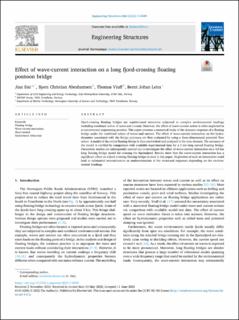Effect of wave-current interaction on a long fjord-crossing floating pontoon bridge
Peer reviewed, Journal article
Published version
Permanent lenke
https://hdl.handle.net/11250/3013542Utgivelsesdato
2022-06-20Metadata
Vis full innførselSamlinger
Originalversjon
https://doi.org/10.1016/j.engstruct.2022.114549Sammendrag
Fjord-crossing floating bridges are sophisticated structures subjected to complex environmental loadings including combined action of wave and current. However, the effect of wave-current action is often neglected in a conventional engineering practice. This paper presents a numerical study of the dynamic response of a floating bridge under the combined action of waves and current. The effect of wave-current interaction on the hydro-dynamics associated with the bridge pontoons are first evaluated by using a three-dimensional potential flow solver. A model of the entire floating bridge is then established and analysed in the time domain. The accuracy of the model is verified by comparison with available experimental data for a 1 km long curved floating bridge. Parametric studies are subsequently carried out to investigate the effect of wave-current interaction on a 4.6 km long floating bridge model for crossing the Bjørnafjord. Results show that the wave-current interaction has a significant effect on a fjord-crossing floating bridge studied in this paper. Neglection of such an interaction could lead to substantial overestimation or underestimation of the structural responses depending on the environmental headings.

